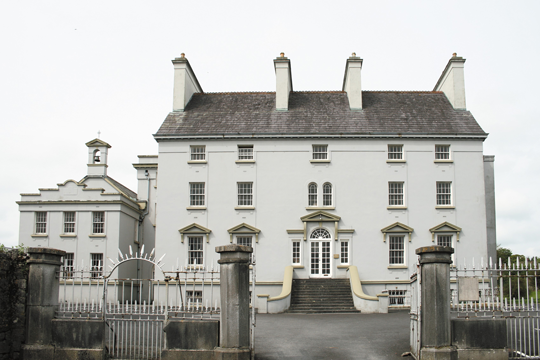ERASMUS SMITH HOUSE COLLEGE ROAD, ENNIS, CO. CLARE
Published in Gems of Architecture, Issue 3 (May/June 2023), Volume 31By Damian Murphy
Erasmus Smith (1611–91) was granted extensive lands under the Settlement of Ireland Act of 1652 as repayment for his support for the suppression of the 1641 Rebellion, and he proposed in December 1655 that some of the profits from those lands be used to endow ‘five school-houses for the teaching of grammar and the original tongue’. A trust established in 1657 was styled ‘The Governors of the Schools Founded by Erasmus Smith’. In 1666 the number of proposed schools was reduced to three—Drogheda, Galway and Tipperary—but unexpectedly high dividends a century later meant that, in addition to supporting a charter school in Sligo, in 1773 the governors resolved to build a school ‘in or near the Town of Ennis’. This school was completed in 1775 at a cost of £1,500.

Above: Erasmus Smith House, built in 1775 and given a neo-Georgian make-over in the mid-twentieth century. (NIAH)
The source of the design for the school is not known, but its rus in urbe quality points to someone experienced in domestic architecture: the tripartite plan, symmetrical façade and classical proportions recall several contemporary country houses in the Shannon region. Two surviving drawings trace the phased development of the school. The first (1798) is a colour-coded basement floor plan showing what was ‘First Built’ and the ‘After Work’. The ‘After Work’, completed c. 1788, saw the rectangular school made quasi-Palladian by the addition of two wings housing classrooms and refectories. The second drawing (1832), by James Pain (1779–1877), illustrates later additions, including a rear wing with long rooms on each floor. Those additions were followed by a new ‘handsome gateway of four octangular pillars’. Its discreet benchmark pre-empted the second age of Erasmus Smith House when, owing to declining attendance, the governors abruptly decided to close the school in December 1890 and lease the premises to the Ordnance Survey.
The Ordnance Survey vacated the building in April 1916 and was followed in quick succession by refugee nuns from Belgium (1916), British soldiers (1916–22), National Army soldiers (1922) and, finally, squatters whose ‘depredations’ included ‘using the oak doors as firewood’ (1923). The school was advertised for public auction in September 1926 but with a reserve of £1,200 did not attract any bidders. Sometime later it came into the charge of the Sisters of Mercy. The intervening years had damaged the fabric and in bringing the building back into use as a boarding-school its façade was given a gentle neo-Georgian make-over by Edward Francis Ryan of Limerick (active 1930s–40s). The central tripartite door-case, previously austere, was made Venetian and given a pediment with unusually elongated consoles; the flanking windows on the ground floor were also given pediments but with comparatively demure consoles. The openings on the upper floors were given low-relief frames and refitted with margined sash windows.
The last boarders left in 1984 but Erasmus Smith House has continued to fulfil its original brief as a centre for education in Ennis, with Maoin Cheoil an Chláir (1994), the first school of music placing equal emphasis on classical and traditional Irish music, followed by the Clare Language Centre (2019).
The Erasmus Smith Schools Architectural Drawing Collection is available on the Digital Repository of Ireland website, www.dri.ie.
Damian Murphy is Architectural Heritage Officer, NIAH. Series based on the NIAH’s ‘building of the month’, https://www.buildingsofireland.ie.
















